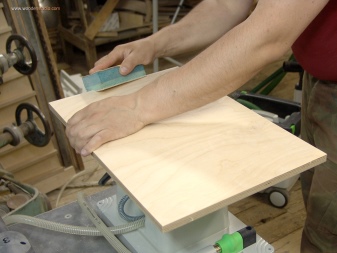How to sand plywood?

Plywood sanding is necessary much more often than it might seem to uninformed people. But before starting this work, it is very important to find out what to grind plywood with. At home, grinding can be done with a grinder, manual belt sander and other tools - and it is important to take into account all their subtleties.


Why do you need resurfacing?
All people try to get the most even and beautiful floor, using various topcoats for this. But first, you still need to use a rough material (substrate), which provides the primary evenness. A plywood sheet is very often used as a substrate. It is suitable for a wide variety of coatings:
-
laminate;
-
linoleum;
-
parquet;
-
tiles;
-
parquet board and so on.


But in its pure form, the use of plywood can be difficult. Even a good product often has rough edges that prevent optimal contact. And therefore, there may be a different number of joints on the floor. It is not necessary to expect that the coating will lie flat on top. There is a way out - just sanding the plywood surface.
For work, they use professional grinding equipment. With its help, all flaws and deviations are guaranteed to be eliminated. The surface is made as smooth as possible, all height differences disappear completely.
The exactingness is much lower than when processing front surfaces, and therefore it will not take much time for this work.

It is worth pointing out the negative consequences of laying out front coatings without grinding:
-
strong creak;
-
the formation of voids that favor decay;
-
significant excess consumption of assembly glue.
The flatness of the floor is checked using a long "rule" or other even plank 1.5-2 m long. When applied to a well-leveled base, the gap will not exceed 2.5 mm. Plywood can also be used as a finishing coat. To do this, it is painted with paints and varnished. But all the same, it is necessary to carefully grind the surface, otherwise it is impossible to achieve a positive effect; it is also worth mentioning that such a procedure is also needed when using the material for decorative purposes.


Instruments
So, the very need for polishing is beyond doubt. However, you still need to figure out how and how to do this. Judging by the reviews on the forums, the primary revision of plywood can be done with orbital sander. The Makita technique gives a good result. Skins with grain are consistently used:
-
240;
-
400;
-
1000;
-
2000;
-
4000.
As a result, the surface will not only be sanded, but literally polished. It is almost impossible to recognize it, and even at first the thought arises that this is not plywood. Vibrating machines also give good results. Working with them is much more practical than a hand-held belt sander.
Orbital systems, however, still benefit when handling large sheets.


But small pieces of plywood are more comfortable to handle with vibrating grinders. Important: they must have a relatively small field. Some masters note the following:
-
grinding the sheet before cutting is best done with an eccentric;
-
the grinder should be used only as a last resort;
-
processing of final products can be performed by both eccentric and vibration mechanisms;
-
tape devices are heavy and impractical in any case;
-
if you have the means and experience, it is most correct to buy a drum machine, which gives the highest processing quality and almost does not emit dust;
-
as a temporary solution, household vacuum cleaners can be connected to conventional grinders, but it is still better to use construction vacuum cleaners or homemade chip suckers.
At enterprises, the process is 100% automated. There are machines with roller feeding of material. Small workpieces are often ground by hand. To do this, use not only sandpaper, but also bars. It is necessary to carefully monitor how hard the abrasive is pressed. It is easier and most convenient to get plywood for furniture (and even more so to process the furniture itself) with an eccentric apparatus.


Stages of work
In domestic conditions, plywood sheets are easy to grind with coarse emery. The grain should be 80s or 100s. For finer processing, then take sandpaper with a smaller grain size. Sanding under the varnish is carried out with fine-grained paper. It must be moved in the longitudinal plane.
In production and in large-scale construction, they do the following:
-
one-sided grinding is performed on machines with 3 or 4 drums;
-
double-sided requires already 6-8 drum sets;
-
regrinding is performed on professional tape equipment;
-
before grinding, sheets are measured with limiting calibers, rejecting everything that differs from the norm by more than 0.5 mm;
-
sheets are fed to the machine at a speed of 7-8 m per second.

Useful Tips
Handling plywood with your own hands correctly at home is not so easy. It has a special structure, which makes it better to work with the utmost care. If the upper level of the veneer is excessively touched during operation, a "burn" will appear, that is, a darker deep mass will come out. When laying under parquet and other materials, this, however, does not matter.
But when the plywood is shown openly, you can show originality. A number of unusual effects are achieved by alternating “burned” at different depths and “clean” areas. The alternation of tones in a particular case is selected individually. If there is no desire to change the color at all, they put pencil or marker marks, replacing the beacons.
End edges should be rounded to prevent flaking and to achieve visual cleanliness.


How to sand plywood, see the video.













The comment was sent successfully.